Sayyid[a] (UK: /saɪɪd, ˈseɪjɪd/, US: /ˈsɑːjɪd/;[6][7][8] Arabic: سيد [ˈsæjjɪd]; Persian: [sejˈjed]; meaning 'sir', 'Lord', 'Master';[9] Arabic plural: سادة sādah; feminine: سيدة sayyidah; Persian: [sejˈjede]) is an honorific title of Hasanids and Husaynids Muslims, recognized as descendants of the Islamic prophet Muhammad through his grandsons, Hasan ibn Ali and Husayn ibn Ali,[10]: 31 sons of Muhammad's daughter Fatima and his cousin and son-in-law Ali (Ali ibn Abi Talib).[11]: 149
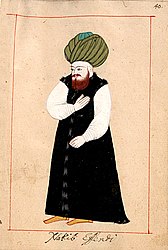 In the Ottoman Empire, the Sayyids had the privilege of wearing a green turban | |
| Regions with significant populations | |
|---|---|
| Muslim world | |
| Religions | |
| Islam | |
| Languages | |
| Arabic, Persian, Somali, Urdu, and others[1][2][3][4][5] |

Along with Alvis (who are the non-Fatimid descendants of Ali), they are a part of Alids.
Etymology
A few Arabic language experts state that it has its roots in the word al-asad الأسد, meaning "lion", probably because of the qualities of valor and leadership.[12]: 158 [13]: 265 The word is derived from the verb sāda, meaning to rule. The title seyyid/sayyid existed before Islam, however not in light of a specific descent, but as a meritocratic sign of respect.[14]
Hans Wehr Dictionary of Modern Written Arabic defines seyyid as a translation for master, chief, sovereign, or lord.[15] It also denotes someone respected and of high status.
In the Arab world, sayyid is the equivalent of the English word "liege lord" or "master" when referring to a descendant of Muhammad, as for example in Sayyid Ali Sultan.[16][17]
Origin of the title
The foundation of the title Sayyid is unclear. In fact the title Sayyid as a unified reference for descendants of Muhammad did not exist according to Monimoto until the Mongol conquests.[18] This can be substantiated by historic records about Abdul Qadir Gilani and Bahauddin Naqshband, who did not refer to themselves with any title, despite their lineages to Muhammad. Sometimes the ruling community of a nation, took this title to portray themselves as respected and honored, though they are not actually the descendants of Muhammad. This gives reasons to think that this title is founded later on. Monimoto refers to Mominov, who describes that the emergence of a community leader during the Mongol era (Ilkhanate) gave rise to the prominence of the title Sayyid.[19] This leader is most probably the Sunni Shafiite scholar Mir Sayyid Ali Hamadani, who lived in this time, being known as a saint credited with the honorific titles "Amir-e-Kabir"(English: Grand Prince) and "Ali-e-Saani" (English: Second Ali).[20] Hamadani's religious legacy in Kashmir as well as his headquarter (Persian: Khanqah) the Khanqa-e-Mola became under the control of the Grand Sayyid Hazrat Ishaan. Hazrat Ishaan's descendants are buried in Hamadani's headquarter, on which occasion it is known as the Ziyarat Naqshband Sahab today.[21][22][23]
However in Sunni Islam as practiced in the Ottoman and Mughal Empire, a person descending from Muhammad (either maternally or paternally) can only claim the title of Sayyid meritocratically by passing audits, whereupon exclusive rights, like paying lesser taxes, will be granted. These are mostly based on the claimant's demonstrated knowledge of the Quran and piousness (Arabic: Taqwa) under the assessment of a Naqib al-Ashraf, also known as a Mir in Persian-speaking countries.[24][25][26] Notable examples of such a Naqib (plural: "Nuqaba") or Mirs (plural: "Miran"), were Hazrat Ishaan in the Mughal Empire and his descendant Sayyid Mir Fazlullah Agha in Royal Afghanistan.[24]
In Shia Islam, with the advent of the Safavids a male person with a non-Sayyid father and a Sayyida mother claims the title of Mirza.
Statistics
Although reliable statistics are unavailable, conservative estimates put the number of Sayyids in the tens of millions.[27]
Traditions
Traditionally, Islam has had a rich history of the veneration of relics, especially of those attributed to Muhammad.[28] The most genuine prophetic relics are believed to be those housed in the Hirkai Serif Odasi (Chamber of the Holy Mantle) in Istanbul's Topkapı Palace.[29][30][31]
Other indication of descent
In addition to the sayyid title, descendants of Muhammad through the Twelve Imams in Arabic, Persian and Urdu may obtain the following surnames:[32]
| Ancestor | Arabic style | Arabic last name | Persian last name | Urdu last name |
|---|---|---|---|---|
| Ali ibn Abi Talib | al-Alawi العلوی او الهاشمی | al-Alawi العلوی al-Hashimi الهاشمي | Alavii, Alavi, or Alawi | Alvi or Hashimi or Awan or Hashemi |
| Hasan ibn Ali | al-Hasani الحسني او الهاشمي | al-Hasani الحسني al-Bolkiah البلقية al-Alawi العلوی al-Hashimi الهاشمي | Hashemi هاشمی Hassani حسنى | Hashmi ہاشمی or Hassani حسنی Noshahi نوشاہی |
| Husayn ibn Ali | al-Hussaini1 الحُسيني | al-Hussaini الحسيني | Hussaini حسيني | Hussaini حسيني Hashemi or Shah[33] |
| Ali ibn Husayn Zayn al-Abidin | al-Abidi العابدي | al-Abidi العابدي | Abedi عابدى | Abidi or Abdi عابدی |
| Muhammad al-Baqir | al-Baqiri الباقري | al-Baqiri الباقري | Baqiri باقری | Baqri باقری |
| Ja'far al-Sadiq | al-Ja'fari الجعفري | al-Ja'fari or al-Sadiq/Sadegh الصدق او الجعفري | Jafari or Sadeghi جعفرى/ صادقی or Dibaji/Dibaj دیباج/دیباجی | Jafri or Jafry جعفری or Jaffery shamsi جعفریشمسی |
| Zayd ibn Ali | az-Zaidi الزيدي | al-Zaydi الزيدي | Zaydi زیدی | Zaidi زیدی |
| Musa al-Kadhim | al-Moussawi الموسوي او الكاظمي | al-Moussawi or al-Kadhimi الموسوي او الكاظمي | Moosavi or Kazemi موسوى / کاظمى | Kazmi کاظمی |
| Ali al-Ridha | ar-Radawi الرضوي | al-Ridawi or al-Radawi الرضوي | Razavi or Rezavi رضوى | Rizvi Razvi or Rizavi رضوی |
| Muhammad at-Taqi | at-Taqawi التقوي | al-Taqawi التقوي | Taqavi تقوى | Taqvi تقوی |
| Ali al-Hadi | an-Naqawi النقوي | al-Naqawi النقوي or al-Bukhari البخاري or al-Qasimi القاسمی | Naghavi نقوى | Naqvi نقوی or Bhaakri/Bukhari بھاکری/بخاری |
| Hasan al-Askari[34][35][36] | al-Askari العسکري | al-Askari العسکري | Sadat سادات Dakik دقيق or Hazrat Ishaan حضرت ایشان | Dakik دقيق or Hazrat Ishaan حضرت ایشان |
Note: (For non-Arabic speakers) When transliterating Arabic words into English there are two approaches.
1Also, El-Husseini, Al-Husseini, Husseini, and Hussaini. 2Those who use the term Sayyid for all descendants of Ali ibn Abi Talib regard Allawis or Alavis as Sayyids. However, Allawis are not descendants of Muhammad, as they are descended from the children of Ali and the women he married after the death of Fatima, such as Umm ul-Banin (Fatima bint Hizam). Those who limit the term Sayyid to descendants of Muhammad through Fatima, Alawites are the same how Sayyids. | ||||
Some Sayyids are Najeeb Al Tarfayn, meaning "Noble on both sides", which indicates that both of their parents are Sayyid.
Existence of descendants of Hasan al-Askari

The existence of any descendant of Hasan al Askari is disputed by many people. Some genealogies of Middle Eastern and Central Asian families (mostly from Persia), East Africa (mostly in Somaliland and Ethiopia), Khorasan, Samarqand, and Bukhara show that Hasan al-Askari had a second son called Sayyid Ali Akbar, which indicates that al-Askari had children and substantiates the existence of Muhammad al Mahdi. Whether in fact al-Askari did have children is still disputed, perhaps because of the political conflicts between the followers of the Imamah and the leadership of the Abbasids and Ghulat Shiites who do not believe in Hasan al-Askari's Imamah.[37] Another group of historians studying the pedigrees of some Central Asian saints' shejere (genealogy trees) believe that the Twelfth Imam was not the only son of Hasan al-Askari, and that the Eleventh Imam had two sons: Sayyid Muhammad (i.e., the Shia Mahdi) and Sayyid Ali Akbar.[36][38][35][39] According to the earliest reports as from official family tree documents and records , Imam Hasan al-Askari fathered seven children and was survived by six. The names of his biological children were: Imam Muhammad al-Mahdi, Musa, Ja’far, Ibrahim, Fatima, Ayesha, and ‘Ali, sometimes referred to as Akbar, Asghar or Abdullah.[35][39]

Sayyid ‘Ali Akbar bin Imam Hasan al-Askari is Sultan Saadat (Sodot) who died in Termez. His burial place is located in the main mausoleum Sultan Saodat memorial complex in Termez.[40][41][42][43][44] According to other old genealogical sources Sayyid Ali was the second son of Sayyid Imam Muhammad al Askari who is considered the elder brother of imam Hasan al-Askari[45][46][47][48][49]
These Central Asian notable sayyid families have historical genealogical manuscripts that are confirmed with seals by many Naqibs, Muftis, Imams, Kadi Kuzzats, A’lams, Khans, and Emirs of those times. One descendant of Sayyid Ali Akbar was Saint Ishan (Eshon) Imlo of Bukhara. Ishan Imlo[50] is called "saint of the last time" in Bukhara,[51] as it is believed that after him there were no more saints – Asian Muslims generally revere him as the last of the saints. According to the source, Ishan Imlo died in 1162 AH (1748–1749); his mausoleum (mazar) is in a cemetery in Bukhara.[51] Notable descendants of Sayyid Ali Akbar are Sufi saints like Bahauddin Naqshband,[52][53][54] descendant after eleven generations;[34] Khwaja Khawand Mahmud known as Hazrat Ishaan, descendant after eighteen generations; the two brothers Sayyid ul Sadaat Sayyid Mir Jan and Sayyid ul Sadaat Mir Sayyid Mahmud Agha, maternal descendants of Hasan al Askari;[34] qadi Qozi Sayyid Bahodirxon;[55][56] and Sufi saints Tajuddin Muhammad Badruddin and Pir Baba.
In her book Pain and Grace: A Study of Two Mystical Writers of Eighteenth-Century Muslim India, Dr. Annemarie Schimmel writes:
Khwaja Mir Dard's family, like many nobles, from Bukhara; led their pedigree back to Baha'uddin Naqshband, after whom the Naqshbandi order is named, and who was a descendant, in the 11th generation of the 11th Shia imam al-Hasan al-Askari.[57]
Although Shiite historians generally reject the claim that Hasan al-Askari fathered children other than Muhammad al-Mahdi, Bab Mawlid Abi Muhammad al-Hasan writes, in the Shiite hadith book Usul al-Kafi:
When the caliph got news of Hasan 'Askari's illness, he instructed his agents to keep a constant watch over the house of the Imam...he sent some of these midwives to examine the slave girls of the Imam to determine if they were pregnant. If a woman was found pregnant she was detained and imprisoned....[34][58][59][60][61][62]
Middle East
Men belonging to the Sayyid families or tribes in the Arab world used to wear white or ivory coloured daggers like jambiyas, khanjars or shibriyas to demarcate their nobility amongst other Arab men, although this custom has been restricted due to the local laws of the variously divided Arab countries.
Iraq
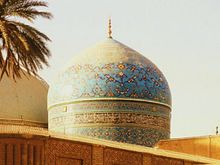

The Sayyid families in Iraq are so numerous that there are books written especially to list the families and connect their trees. Some of these families are: the Alyassiri, Al Aqeeqi, Al-Nasrullah, Al-Wahab, Al-Hashimi, Al-Barznji, Al-Quraishi, Al-Marashi, Al-Witry, Al-Obaidi, Al-Samarai, Al-Zaidi, Al-A'araji, Al-Baka, Al-Hasani, Al-Hussaini, Al-Shahristani, Al-Qazwini Al-Qadri, Tabatabaei, Al- Alawi, Al-Ghawalib (Al-Ghalibi), Al-Musawi, Al-Awadi (not to be confused with the Al-Awadhi Huwala family), Al-Gharawi, Al-Sabzewari, Al-Shubber, Al-Hayali, Al-Kamaludeen, Al-Asadi and many others.[63][64][65]
Iran
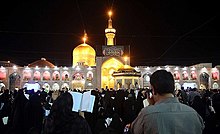
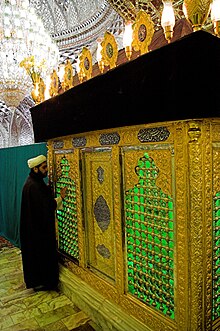
Sayyids (in Persian: سید Seyyed) are found in vast numbers in Iran. The Chief of "National Organization for Civil Registration" of Iran declared that more than 1 million of Iranians are Sayyid.[66] The majority of Sayyids migrated to Iran from Arab lands predominantly in the 15th to 17th centuries during the Safavid era. The Safavids transformed the religious landscape of Iran by imposing Twelver Shiism on the populace. Since most of the population embraced Sunni Islam, and an educated version of Shiism was scarce in Iran at the time, Ismail imported a new group of Shia Ulama who predominantly were Sayyids from traditional Shiite centers of the Arabic-speaking lands, such as Jabal Amel (of southern Lebanon), Syria, Bahrain, and southern Iraq in order to create a state clergy. The Safavids offered them land and money in return for loyalty.[67][68][69][70][71] These scholars taught Twelver Shiism, made it accessible to the population, and energetically encouraged conversion to Shiism.[68][69][70][71][72]
During the reign of Shah Abbas the Great, the Safavids also imported to Iran more Arab Shias, predominantly Sayyids, built religious institutions for them, including many Madrasas (religious schools), and successfully persuaded them to participate in the government, which they had shunned in the past (following the Hidden imam doctrine).[73][self-published source?]
Common Sayyid family surnames in Iran are Husseini, Mousavi, Kazemi, Razavi, Eshtehardian, Tabatabaei, Hashemi, Hassani, Jafari, Emami, Ahmadi, Zaidi, Imamzadeh, Sherazi, Kermani (kirmani), Shahidi, and Mahdavi.[citation needed]
Bahrain
In Bahrain Sayyids are used to refer to great-grandchildren of Muhammed. Sayyids are found every where and in vast populations although number contradict. Sayyids started living in Bahrain since the beginning of the 8th century. The Bahrainis supported, Imam Ali in his wars in the Camel, Siffin and Nahrawan, and several Bahraini men emerged from the leaders of the Commander of the Faithful including the companion Zayd ibn Suhan al-Abdi who was killed in the Battle of the Camel when he was fighting alongside the Commander of Imam Ali. And the companion Sa'sa'a bin Sohan Al Abdi who was the ambassador of the Commander of the Faithful to Mu`awiyah, and he and Mu`awiyah have many stories that historians have transmitted to us. Historians have called them this title because they agreed on a Thursday that they would die for the sake of the Commander of the Faithful. The tomb of Zayd ibn Suhan is still visited in Bahrain and is called by Bahrainis as Prince Zaid, as well as the tomb of the great companion Sa'sa'a bin Sohan Al Abdi who is buried in Bahrain.[citation needed]
Oman
In Oman, Sayyid is not used for descendants of Muhammad, but by members of the Al Said ruling royal family, who have no connection to Muhammad.[74] The absolute ruler of the country retains the title Sultan with members of the royal family eligible for succession to the throne given the title Sheikh, these may also use the title Sayyid should they wish to, although as Sheikh supersedes this, it is not a widely used practice.[citation needed] Members of the extended family or members by marriage carry the title Sayyid or Sayyida for a female. Such titles in Oman are hereditary through paternal lineage or in some exceptional circumstances, such as an honorary title given by royal decree. Members of the Al Said family use the term Sayyid solely as a title and not as a means of indicating descent, as the Al Said royal family does not descend from Banu Hashim or from Imam Ali and instead descends from the Qahtanite Zahran tribe.[75]
Yemen
In Yemen the Sayyids are more generally known as sadah; they are also referred to as Hashemites. In terms of religious practice they are Sunni, Shia, and Sufi. Sayyid families in Yemen include the Rassids, the Qasimids, the Mutawakkilites, the Hamideddins, some Al-Zaidi of Ma'rib, Sana'a, and Sa'dah, the Ba 'Alawi sadah families in Hadhramaut, Mufadhal of Sana'a, Al-Shammam of Sa'dah, the Sufyan of Juban, and the Al-Jaylani of Juban.[76][77][78]
South Asia


In South Asia, Sayyids are mostly credited for preaching and consolidating the religion of Islam. They are predominantly descendants of leading saints of Sunni faith that migrated from Persia to preach Islam of which the Persian Sayyid Moinuddin Chishti has set the cornerstone. Thus Moinuddin Chishti is regarded as Sultan-i-Hindustan in Islamic Theology.[79][80] The following saints and their descendants are most well known:
- Bulleh Shah
- Sayyid Haji Muhammad Noshah Ganj Baksh Qadiri
- Sayyid Abdul Latif Shah, known as Bari Imam Sarkar
- Mir Sayyid Ali Hamadani
- Sayyid Jalaluddin Surkh Posh Bukhari
- Sayyid Awn Qutb Shah Wali
- Sayyid Abdul Wahab Gilani, son of Sayyid Abdul Qadir Gilani
- Sayyid Musa Pak Shaheed (ancestor of Yusuf Raza Gillani) and Sayyid Habeeb Shah Gilani (Teacher of Sultan Bahoo)
- Sayyid Moinuddin Chishti
- Sayyid Imam Ali Shah Qalandar
- Lal Shahbaz Qalandar
- Sayyid Badiuddin Zinda Shah Madar
- Bahauddin Naqshband
- Hazrat Ishaan
- Moinuddin Hadi Naqshband
- Sayyid Mir Jan
- Sayyid Mahmud Agha
- Sayyid Mir Fazlullah Agha
- Tajuddin Muhammad Badruddin
- Pir Baba
- Shaal Pir Baba
- Maudood Chishti
- Wali Kirani
- Khwaja Abdullah Chishti
- Ibrahim Yukpasi
- Shah Sayyid Nasruddin
- Sayyid Masud Al-Hussaini
- Syed Shah Sadaruddin Lakyari
North India
The earliest migration of Sayyids from Afghanistan to North India took place in 1032 when Gazi Saiyyed Salar Sahu (general and brother-in-law of Sultan Mahmud of Ghazni) and his son Ghazi Saiyyad Salar Masud established their military headquarters at Satrikh (16 km (9.9 mi) from Zaidpur) in the Barabanki district of Uttar Pradesh. They are considered to be the first Muslim settlers in North India. In 1033 Ghazi Saiyyad Salar Masud was killed at the battle of Bahraich, the location of his mazar. Ghazi Saiyyad Salar Masud had no children. His parental uncle Syed Maroofuddin Ghazi and his family lived in Tijara until 1857 before they migrated to Bhopal. Syed Ahmed Rizvi Kashmiri and Khan Bahadur Aga Syed Hussain were both Rizvi Sayyids through Aaqa Meer Sayyid Hussain Qomi Rizvi, whose sacred shrine is in the Zainageer Village of Sopore, Kashmir. Iraqi Sayyids or Iraqi biradri in Eastern Uttar Pradesh are descendants of Sayyid Masud Al Hussaini who was the direct descendant of Muhammad's grandson Hussain ibn Ali and came to India from Iraq during the reign of Sultan Muhammad bin Tughlaq in 1330 A.D. He settled with his seven sons and forty champions in Ghazipur (U.P.) as some of them (i.e., Syed Abu Bakr in Nonahra, Ghazipur) converted to Sunni Islam in the reign of Sultan Ibrahim Lodhi around 1517. His Shia descendants are now known as Sayyids of Ghazipur.[81]
Sayyids of Syed nagli, or Said Nagli, or the Baquari Syeds had migrated from Termez (Present day Uzbekistan)[82] during the Sultanate era. Sikandar Lodi[83] was the ruler of Delhi when Mir Syed Mohammad al Hussain al Hussaini al Termezi Haji al Haramain came to India and settled at Syed Nagli. He was a Baquari Syed who drew his lineage from Muhammad al Baqir.
Perhaps the most important figure in the history of the Sayyid in Uttar Pradesh was Sayyid Basrullah Shustari, who moved from Mashad in Iran in 1549 and joined the court of the Mughal Emperor Akbar. Akbar appointed Shustari as his chief justice, who used his position to strengthen the status of the various Sayyid families. They were preferred in administrative posts and formed a privileged elite. When the Mughal Empire disintegrated, the Sayyid played an important role in the turbulent politics of the time. The new British colonial authorities that replaced the Mughals after the Battle of Buxar made a pragmatic decision to work with the various Sayyid jagirdars. Several Sayyid taluqdars in Awadh were substantial landowners under the British colonial regime, and many other Sayyid contributed to state administration.[84] After the abolition of the zamindari system, many Sayyid zamindars (e.g. that of Ghazipur) had to leave their homes.[85]
Uttar Pradesh
The ancestor of the Bārha Sayyids, Sayyid Abu'l Farah Al Hussaini Al Wasti, left his original home in Wasit, Iraq, with his twelve sons at the end of the 13th century and migrated to India, where he obtained four villages in Sirhind-Fategarh. By the 16th century Abu'l Farah's descendants had taken over Bārha villages in Muzaffarnagar.[86]
The Sayyeds of Abdullapur Meerut are descendants of great saint Jalaluddin Surkh-Posh Bukhari. They had a large Jagirdara consisting of 52 villages.Abdullapur named after Syed Mir Abdulla Naqvi Al Bukhari, he built Kot Fort of this place in the 16th century, it was his main residence.[87][88][89][90] Bukhari of Abdullapur are fractionate into Kannauji Bukhari and Jalal Bukhari. Kannauji's are descendants of Jalaludin Haider through Syed Mehboob Alam Naqvi-ul Bukhari Al-Maroof Shah Jewna or Shah Jewna son of warrior and chief advisor of Sikandar Lodi.[91][92][93][94] Famous writer Syed Qudrat Naqvi Al Bukhari was born here later migrated to Pakistan after partition, his famous books are Ghalib kaun hai, Asaas-i-Urdu, Ghalib-i-sad rang, Seerat-un-Nabi, Hindi-Urdu lughat, Mutal'a-i-Abdul Haq, Lisani maqalaat.[95]
The Sayyids of Bilgram are Hussaini Sayyids, who first migrated from Wasit, Iraq, in the 13th century.[96] Their ancestor, Syed Mohammad Sughra, a Zaidi Sayyid of Iraq, arrived in India during the rule of Sultan Iltutmish. In 1217–18 the family conquered and settled in Bilgram.[97]
A notable Sufi that belonged to a Sayyid family was Syed Salar Masud, from whom many of the Sayyid families of Awadh claim their lineage.[84] Sayyids of Salon (Raebareli), Jarwal (Bahraich), Kintoor (Barabanki), and Zaidpur (Barabanki) were well-known Taluqadars (feudal lords) of Awadh province.
Sadaat also found in Kannauj trace their lineage from Husayn through Ali al-Hadi, a branch of Naqvi Bukhari. Famous Pir Syed Mehboob Alam Naqvi-ul Bukhari Al-Maroof Shah Jewna son of great warrior Syed Sadaruddin Shah Kabeer Naqvi (saint and also chief advisor) of Sikandar Lodi was also born in Kannauj and spent 66yrs of his life in kannauj later moved to Shah Jeewna. Makhdoom Jahaniya Mosque is still present in Shikana, Kannauj.[92][94][93] Nawab Siddiq Hasan Khan was also from Kannauj, he is a Bukhari Naqvi Sayyed converted from Shi'a Islam to Sunni Islam in the early 1800s.[98][99][100]
Bihar
There are different families of syeds in Bihar who belong to direct descendent of Imam Hasan and Imam Hussain. Mostly there are Hussaini (Rizvi, Zaidi, Baqri) along with Hasani (Malik, Quadri or Geelani). Sadaat are settle in different part of bihar including shia and sunni sects. They are mostly migrated to bihar from Iraq and Iran.
The Hasibs from the Sadaat e Rajhat clan are descended from Syed Yaqub Halabi also known as Syed Yaqub Baghdadi, a Hanafi Qazi from MadrassaAl Nizamiyya, originally from Halab (Aleppo) who travelled to India with Muhammad of Ghor after the Second Battle of Tarain. He was an eleventh generational descendent of Ali ibn Husayn Zayn al-Abidin through his son Abu Abdullah Al Asghar.
Sharafuddin Maneri[101] belongs to Banu Hashim family of Imam Taj Faqih. In Bihar, Sayyids were landlords, judges, barristers, intellectuals, civil servant, clerics, teachers, businessmen and farmers. Sufi Saint and a worrior Malik Ibrahim Bayu who conquered Bihar during the time of tughlaq is one the most famous personality in bihar. Bihar's first prime minister Mohammad Yunus[102][103] Nobel prize nominee and Padma shri winner Syed Hassan,[104] Political Scientist Abu Bakr Ahmad Haleem[105] was the Pro-Vice Chancellor of Aligarh University and Karachi University, The great Abdul Bari,[106][107][108] Zaid Hamid Syed Zaid Zaman Hamid is a Pakistani far-right, Islamist political commentator and was included in 500 most influential muslims in world and Brigadier Malik Mokhtar Karim [109] are few names from Malik Sadaat of bihar.
Zaidi Sadaat of Bihar are the descendants of Sufi saint Syed Ahmad Jajneri and Syed Mohammed Jajneri. Syed Ahmad Jajneri migrated to India from Baghdad during the reign of Muhammad of Ghor and later migrated to Bihar. He was the direct descendant of Zayd ibn Ali who was the grandson of Husayn ibn Ali and therefore his descendants are called Husseini(Zaidi)Sadaat. His descendants are mostly settled in Bihar Sharif, Munger, Sheikhpura and Jamui region of Bihar.
Most prominent personalities of Sadaat of Bihar were from Desna, Bihar. For Example Syed Mohammed Saeed Raza, Abdul Qavi Desnavi[110] and Sulaiman Nadvi.[111][112] Desna's library, established in 1892, had thousands of old Persian and Urdu manuscripts. After the partition of India, during uncertain times of mass emigration to Pakistan, the books were donated to Khuda Bakhsh Khan Library in Patna, where a Desna section was established to house these treasures.[111] Other famous personalities of Bihari Syed were Syed Sultan Ahmed, Syed Hasan Imam and Sir Imam Ali .
Kerala
In Kerala, a number of Sayyid families (Qabila) are found. Most of them migrated from Arabian peninsula (Yemen's Hadharamout) and Central Asian region in the middle ages and settled under the patronage of Zamorins. Famous among are Jifris, Bukharis and Ba-Alawis.[113]
Sayyids occupy various postions as jurists (qazi), scholars (ulama') and leaders (umara'). The state leaders of Indian Union Muslim League and Samastha are mostly chosen from Panakkad Thangal Family. A religious educational institute named 'Sadath Academy' was established in Kerala exclusively for Sayyid students.[114]
Genetic studies and controversy of self-proclaimed Indian Sayyids
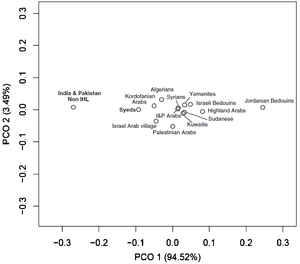
The authors of the study, the Y chromosomes of self-identified Syeds from the Indian sub-continent are no less diverse than those non-Syeds from the same regions, suggested that Syed status showed evidence of elevated Arab ancestry but not of a recent common patrilineal origin.[115]
In Northern India, Uttar Pradesh & Bihar 0.2 per cent of the Sunni Muslim belong to haplogroup J1, which, given its absence in Indian non-Muslims is likely of exogenous Middle Eastern origin. There are 18 per cent belonging mainly to haplogroup J2 and another 11 per cent belong to haplogroup J1, which both represent Middle Eastern lineages, but may not hint exact descent from Muhammad. J1 is exclusively Near Eastern. The results for Sayyids showed minor but still detectable levels of gene flow primarily from Iran, rather than directly from the Arabian peninsula.[116]
The paper, "Y chromosomes of self-identified Syeds from the Indian subcontinent", by Elise M. S. Belle, Saima Shah, Tudor Parfitt, and Mark G. Thomas showed that "self-identified Syeds had no less genetic diversity than those non-Syeds from the same regions, suggesting that there is no biological basis to the belief that self-identified Syeds in this part of the world share a recent common ancestry. However, self-identified men belonging to the IHL (Syeds, Hashemites, Quraysh and Ansari) show greater genetic affinity to Arab populations—despite the geographic distance, than other Indian populations.[117]
Southeast Asia
Most of the Alawi Sayyids who moved to Southeast Asia were descendants of Ali ibn Husayn Zayn al-Abidin, especially of Ba 'Alawi sada, many of which were descendants of migrants from Hadhramaut. Even though they are only "alleged" descendants of Husayn, it is uncommon for the female Sayyids to be called Sayyidah; they are more commonly called Sharifah. Most of them live in Brunei, Indonesia, Malaysia, Singapore, Moro Province in Philippines, Pattani and Cambodia. Many of the royal families of this region such as the previous royal families of the Philippines (Sultanate of Sulu, Sultanate of Maguindanao, Confederation of Sultanates of Ranao), Country of Singapore (Sultanate of Singapore House of Bendahara), Country of Malaysia (Sultanates of Johor House of Temenggong, Sultanates of Pahang and Sultanates of Terengganu House of Bendahara, Kingdom of Perlis House of Jamalullail), Country of Indonesia (Sultanates of Siak, Sultanates of Pontianak, Sultanates of Gowa, some Javanese Sultanates), Country of Brunei (Sultanates of Brunei House of Bolkiah) are also Sayyids, especially of Ba'Alawi.[118][119][120][121]
Some common surnames of these Sayyids are Al-Saqqaf (or As-Saqqaf, Assegaf, Assegaff, Al-Sagoff), Shihab (or Shahab), Al-idaroos (or Al-Aydrus, Al Aidrus, Alaydrus, House of Bendahara, House of Temenggong), Al-Habsyi (or Al-Habshi), Al-Kaff, Al-Aththos (or Al-Attas, Alattas, Alattos), Al-Haddad Alhaddad), Al-Jufri (or Al-Jifri), Al-Muhdhar, Al-Shaikh Abubakar, Al-Qadri, Al-Munawwar, Al-Akbar Al-Hasani (or Al Akbar Al Hasani, Al-Bolkiah, House of Bolkiah), Al-Jamalullail (or Al Jamalullail, Djamalullail, House of Jamalullail).[122]
Tesayyud
In the Ottoman Empire, tax breaks for "the People of the House" encouraged many people to buy certificates of descent or forge genealogies; the phenomenon of teseyyüd – falsely claiming noble ancestry – spread across ethnic, class, and religious boundaries. In the 17th century, an Ottoman bureaucrat estimated that there were 300,000 impostors. In 18th-century Anatolia, nearly all upper-class urban people claimed descent from Muhammad.[123][124]
Royal Descendants of Muhammad
Descendants of Muhammad are present in many royal families today and are predominantly of Sunni faith.
Afghan royal family
Within the Afghan Royal family Her Royal Highness Princess Sayyida Rahima Dakik (d.2006) daughter of General Sayyid Mir Muhammad Jan a member of Sayyid Hasan ibn Azimullah's powerful Sayyid ul Sadaat Clan that claims hereditary succession to Muhammad, married her father's Murid the UN ambassador and minister Prince Abdul Khaliq from the Telai cadet branch of the Muhammadzai Dynasty, making both their descendants (Mir Muhammad Jan Khel sub-cadet branch, called after Princess Rahima's saintly father) the only multilinieal cognatic Sayyids within the Afghan Royal family. They are known by the surname Dakik[125]
Iranian Royal Family

Qajar
Within the Qajar Dynasty, the Nizari-Ismaili Imam Agha Khan I married with the daughter of Fath Ali Shah Qajar, bestowing confirmed royalty upon their descendants. Until today Prince Karim Aga Khan and his descendants bear the title Prince, in virtue of his lineage to Fath Ali Shah Qajar.[126][127] However many Sunni Historians deny the descent of the First Fatimid Caliph Ubaidullah al Mahdi-billah to Muhammad. They thus polemically call them Ubaydids instead of Fatimids.[128][129][130][131]
Pahlavi

Within the Pahlavi Dynasty, the former Empress of Iran Farah Diba Pahlavi, also claims descent from Muhammad through her paternal grandfather Mehdi Diba.[132][133]
GCC Royal families

UAE
The Al Qasimi ruling family that rules over Sharjah and Ras al Khaimah trace their lineage back to Muhammad in the line of the 10th Imam Ali al Hadi.[134][135]
Qatar
Within the Qatari ruling Family, descendants of Muhammad are present within the descendants of the Emir Sheikh Ali ibn Abdullah al Thani on the occasion of intermarriages with the Al Qasimi Dynasty. A UAE Princess from the al Qasimi ruling family, called Sheikha Sheikha bint Muhammad al Qasimi married with Muhammad bin Ali bin Abdullah Al Thani. Together they issued a son who is a Qatari-Sharjan Aviation Statesman called Sheikh Abdullah bin Mohamed. His son is the first descendant of Muhammad to climb Mt. Everest. Another UAE Princess called Sheikha Hind bint Faisal Al Qasimi married Sheikh Abdullah bin Saud al Thani, issuing only one son.[136]
Libyan Royal Family
The Sayyids in Libya are Sunni, including the former royal family, which is originally Zaidi-Moroccan (also known as the Senussi family).[137] The El-Barassa Family are Ashraf as claimed by the sons of Abdulsalam ben Meshish, a descendant of Hassan ibn Ali ibn Abi Talib.
Sherifs of Mecca
Jordan
The Hashemite Royal family of Jordan also claims descent from Muhammad in the line of the Sherifs of Mecca, vassals that were set by the Fatimids and recognized by the Ottomans, tracing their lineage back to Imam Hasan ibn Ali.[138] The Hashemite Royal Family under Sharif Hussein ibn Ali was crucial in ending Ottoman rule in the Arabian Peninsula, on the occasion of the spread of Pan-Turkism in the Arabian Peninsula.[139]
Brunei
The House of Bolkiah claims descent from Imam Hasan ibn Ali through Sharif Ali, the 3rd Sultan of Brunei, who succeeded his father in law as Sultan in virtue of his descent from Muhammad. Sharif Ali formerly served as Emir of Makkah and belonged to the Sherifians, migrating to Brunei for missionary purposes.[140]
Moroccan Royal family
The Alaouite Royal family of Morocco also claims descent from Muhammad in the line of Imam Hasan ibn Ali. Their pratriarch was Sharif ibn Ali, who founded the dynasty.[141]
Sulu, Lanao and Maguindanao royal family
The Sultanates of Sulu, Lanao, and Maguindanao hold a significant place in Philippine history, rooted deeply in both cultural heritage and religious identity. It is widely acknowledged that these Sultanates trace their lineage to the esteemed lineage of the Prophet Muhammad ﷺ, upholding the tenets of Sunni Ash'ari in Aqeeda (theological creed) and adhering to the Shafi'i school of thought in Fiqh (jurisprudence). Central to their spiritual and intellectual tradition are the teachings of Sufi missionaries from the Ba 'Alawi sada, whose influence has played a pivotal role in shaping the religious landscape of the region.[142]
The majority of Muslims in the Philippines adhere to the Sunni Ash'ari creed and follow the Shafi'i school of jurisprudence, reflecting the enduring influence of these traditions within the Sultanates and beyond. Furthermore, there exists a profound respect for, and in many cases, the practice of Sufism among Filipino Muslims. Sufism, with its emphasis on spiritual purification and the pursuit of inner knowledge, resonates deeply with the cultural and religious fabric of the Filipino Muslim community.[143]
See also
- Family tree of Muhammad
- Mir Sayyid Ali Hamadani, most probable originator of the title, influencing the Sunni opinion of definition
- Hazrat Ishaan, succeeding Hamadani's clerical legacy
- Mir (Persian Princes of the Sayyids)
- Naqib (Arabian Sheikhs of the Sayyids)
- Safavid Empire, whose clerics influenced the Shiite opinion of definition
- Sadat (disambiguation)
- Mirza (title)
Notes
References
Sources
- This article incorporates text from a publication now in the public domain: Chisholm, Hugh, ed. (1911). "Sayad". Encyclopædia Britannica (11th ed.). Cambridge University Press.
- Van Arendonk, C.; Graham, W.A. (1960–2007). "Sharīf". In Bearman, P. J.; Bianquis, Th.; Bosworth, C. E.; van Donzel, E.; Heinrichs, W. P. (eds.). Encyclopaedia of Islam, Second Edition.
- whyislam.org content

